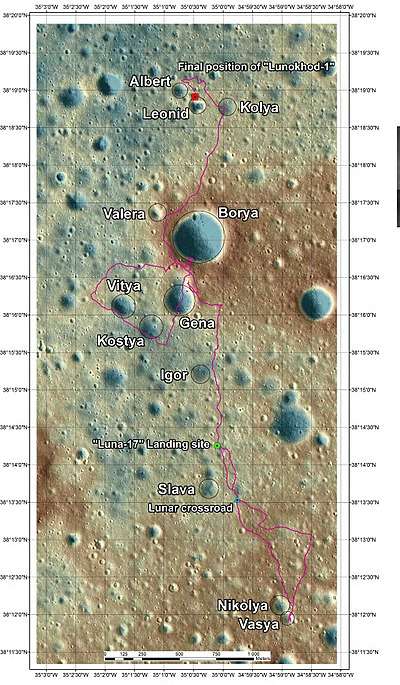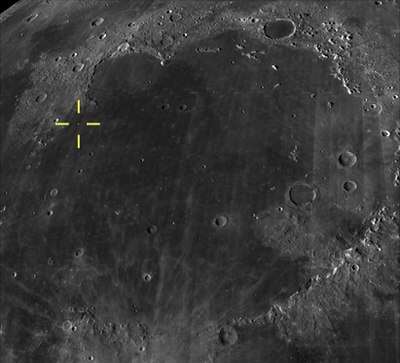Borya (crater)
 Map of the minor features that the rover Lunokhod-1 passed, Borya is above the middle of the photo | |
| Coordinates | 38°17′04″N 35°00′25″W / 38.2845°N 35.007°WCoordinates: 38°17′04″N 35°00′25″W / 38.2845°N 35.007°W |
|---|---|
| Diameter | c. 400 m |
| Depth | Unknown |
| Eponym | Russian male name |

Borya is a tiny lunar craterlet located in the northwest part of the Mare Imbrium in the northwest of the lunar near side. The craterlet is located south of the smaller Kolya, Leonid and Albert craterlets, very close to the northwest is Valera, south is Gena located under a craterlet diameter and nearby are the craterlet twins of Vitya and Kostya. Major features include Promontorium Heraclides, located 30 km north, and C. Herschel crater located about 150 km south-southeast, the closest to where Lunokhod 1 visited.
Description
The crater is named after the dimunitive form of the Russian male name Boris, one of the 12 craterlet names in the area where Lunokhod 1 passed that were approved by the International Astronomical Union (IAU) on June 14, 2012.[1] Also it is the largest of the 12 craterlets where Lunokhod 1 visited, with a diameter of about 400 metres.
The Soviet lander Luna 17 crossed at the northeast rim of the crater between March and April 1971. After visiting the craterlet now Gena, the lander after making a left turn headed north to the larger craterlet. The lander entered the crater then made a small right curve before going west, then south and shorty exited the craterlet and headed to what are now Kostya and Vitya. Around July, the lander headed within the vicinity of the craterlet, it turned northwest at the area of the previous lander's tracks and headed for the last time into the craterlet and headed distant to near a craterlet now Valera then turned northeast close to the northern rim and headed to the last three craterlets to the north that are now Kolya, Albert and Leonid before the mission was complete. The location and the lander's tracks were founded in a Lunar Reconnaissance Orbiter image on March 17, 2010 by Albert Abdrakhimov.[2][3]
Location

See also
- Boris (crater) - a crater also named after the male name related to Boris
- Rupes Boris
References
- ↑ "Borya". Gazetteer of Planetary Nomenclature. International Astronomical Union. Retrieved October 24, 2017 – via usgs.gov.
- ↑ Lakdawalla, Emily (March 17, 2010). "And now for Luna 17 and Lunokhod 1". Planetary Report.
- ↑ "LROC Observation M114185541R". Arizona State University.
External links
| Wikimedia Commons has media related to Borya (crater). |
- Borya at The Moon Wiki
- "Lunokhod-1 traverse map (Landing site Luna 17)" (PDF). Moscow State University of Geodesy and cartography (MIIGAiK), German Aerospace Center (DLR). 2012. Archived (PDF) from the original on 2013-02-22. Retrieved 2017-10-16.
- Wood, Chuck (June 16, 2012). "Overdue Names". Lunar Photo of the Day. Retrieved October 24, 2017.
